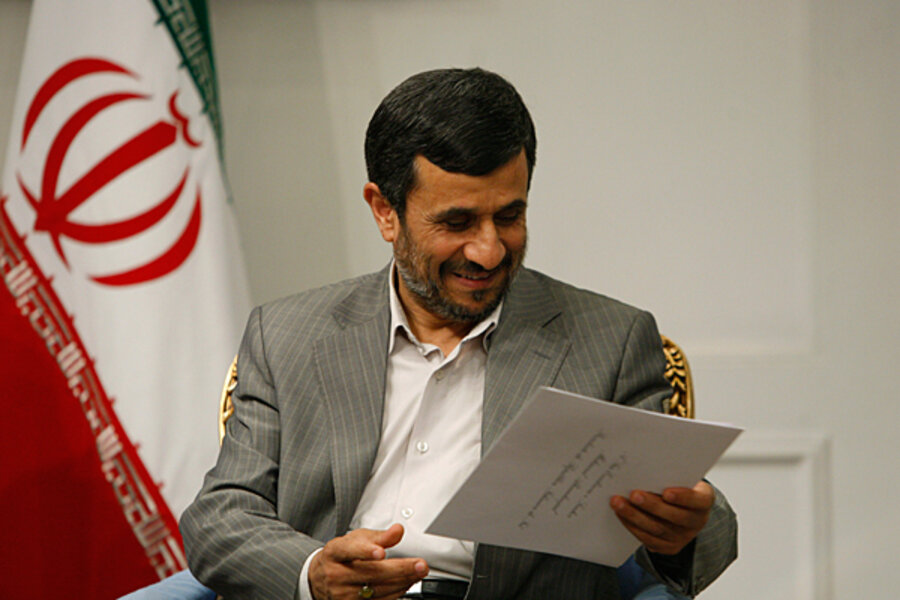Why Iran's Ahmadinejad is pushing to cut popular government subsidies
Loading...
| Washington
On the eve of his visit to the US next week, Iranian President Mahmoud Ahmadinejad has been pushing parliament to cut $40 billion in government subsidies. As Iran braces for fresh United Nations sanctions over its controversial nuclear program as well as a possible rise in inflation rates, the president seeks to convert the subsidy money into a slush fund with little government oversight.
The subsidies, which Mr. Ahmadinejad says benefit Iran's wealthy more than the poor, are slated to be replaced with monthly cash handouts to the mainly lower-income sectors of the population, with compensation currently estimated to be worth roughly 200,000 rials ($20) a person, according to local analysts. Critics say the president would use the funds as a political tool to bolster his position.
“There is the danger of dissent or discontent catapulting among the poor. They want to make sure they have enough money to deal with any sort of price rise that may result [from the cuts],” says a Tehran-based analyst, who spoke on condition of anonymity due to the sensitivity of the issue. “It gives the government an extremely free hand in serving its base constituency.”
Iran spends $90 to $100 billion on annual subsidies
Though relations between Ahmadinejad and Iran's Majles, or parliament, were mercurial at best during his first presidential term, most Iranian lawmakers rallied behind the president after the country's contested elections last June. They reinforced their support for Ahmadinejad's administration in late October by backing controversial legislation to phase out subsidies for fuel, water, flour, bread, wheat, rice, oil, milk, sugar, and postal and transportation services by March 2014.
The Islamic Republic spends between $90 billion to $100 billion per year on subsidies. Of that, $35 billion to $45 billion goes to fuel subsidies, which include gasoline, heating oil, kerosene, liquefied petroleum gas or LPG, and fuel oil, according to interviews with government officials.
Parliamentarians already approved a subsidy cut of $20 billion in January. Under the deal, a new government entity will be given the $20 billion to disperse as they see fit – outside the purview of the national budget, and thus with little to no parliamentary oversight.
But Ahmadinejad has been battling MPs for more comprehensive legislation to cut subsidies by double that amount. The aim is to ensure that his administration will have enough cash on hand to raise payments to his predominantly low-income constituency in the case that utility and fuel prices rise more than government projections, according to domestic analysts.
Though the parliament isn't likely in the near-term to double the subsidy cut to $40 billion, it has granted Ahmadinejad's government the freedom to disperse the $20 billion worth of yearly subsidies over a six- or nine-month period, allowing larger individual cash payments that are on par with those that would have been made with a larger subsidy cut. His administration will also be able to allocate different payment amounts to different people.
Calls for subsidy cuts as early as 1992
Domestic economists and lawmakers have privately called for subsidy cuts since at least 1992. They advocated spending part of the savings on cash handouts, which would leave the government with extra funds and enable Iranians to pay fair market prices for energy – allowing Iran to invest more in its aging oil infrastructure.
But many economists claim the lack of transparency about how the government will ultimately disburse the cash payments could cause massive hikes in inflation.
“Everybody agrees we need to get rid of our subsidies because it puts too much unhealthy pressure on the government. But nobody knows how the groupings are going to be determined and who will actually get the payments,” says the Tehran-based analyst. “[The methodology] with which Ahmadinejad actually goes about doing it could have a fundamentally catastrophic impact on the economy.”
Economists predict the president will seek an addendum to the subsidy bill allowing his government to start implementing the subsidy plan during the second half of the Iranian new year, which began on March 21.
“The government is allowed to allocate $20 billion for this year, but how it does so is up to the government,” says a former economic official in Tehran. “The government wanted a free hand and didn't want to go through the budget, and they got that. There will be another addendum.... They may just start in the second half of the year.”
Ahmadinejad's move could hurt economy
For now, Ahmadinejad appears to be in a strong position, with the tacit backing of supreme leader Ayatollah Ali Khamenei, who has final say on all state affairs. The Iranian president won a small victory in early April after Ayatollah Khamenei made a public statement supporting a compromise between the parliament and Ahmadinejad.
“Ahmadinejad keeps running back and saying we are in a state of emergency; that we have internal issues so we need to show a strong government moving forward with its programs. This is pure politics,” says the analyst. “[But] this is an economy that works in a trickle-down process, and is slowing down. To do this now, at this point in time, may be the last thing the economy needs.”
Related:





